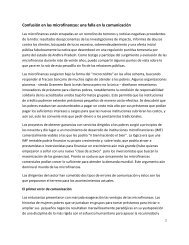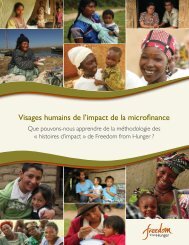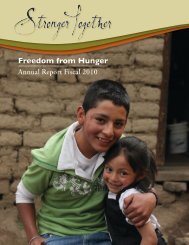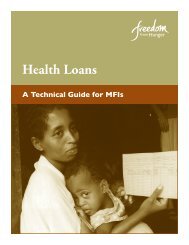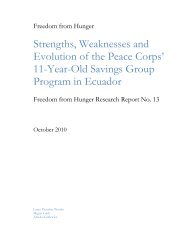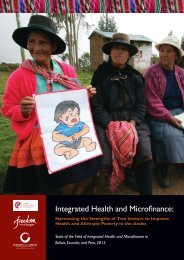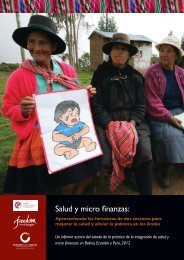history of meals for millions, soy, and freedom from ... - SoyInfo Center
history of meals for millions, soy, and freedom from ... - SoyInfo Center
history of meals for millions, soy, and freedom from ... - SoyInfo Center
You also want an ePaper? Increase the reach of your titles
YUMPU automatically turns print PDFs into web optimized ePapers that Google loves.
101. Hendrick, Kimmis. 1955. ‘Meals <strong>for</strong> Millions’ grows.<br />
Christian Science Monitor. Nov. 4. p. 4. *<br />
• Summary: Mentions Florence Rose <strong>of</strong> the Meals <strong>for</strong><br />
Millions Foundation. Address: Head, Pacific News Bureau<br />
<strong>of</strong> The CSM.<br />
102. Abrahams, Maurice Martin. 1955. Sees Brazil, U.S.<br />
market <strong>for</strong> <strong>soy</strong>. Soybean Digest. Dec. p. 24.<br />
• Summary: “As a licensee <strong>for</strong> Brazil <strong>of</strong> the Meals <strong>for</strong><br />
Millions Foundation–the prime mover in many food<br />
research programs throughout the world–we have<br />
developed here a really superlative Multi-Purpose Food<br />
consisting almost exclusively <strong>of</strong> defatted soja, vitamins <strong>and</strong><br />
minerals...<br />
“The importance <strong>of</strong> our program down here is that our<br />
product will serve two basic interests <strong>of</strong> governmental<br />
authorities: 1. Promote <strong>soy</strong>bean cultivation. 2. Promote the<br />
consumption <strong>of</strong> <strong>soy</strong>bean products by humans so that these<br />
humans can receive far better nourishment at lower cost.”<br />
Address: Sao Paulo, Brazil.<br />
103. Marshall, Eleanor M. 1955. Meals fMr <strong>millions</strong>.<br />
American Mercury 81:83-85. Dec.<br />
• Summary: This is the story <strong>of</strong> Multi-Purpose Food, which<br />
can be sold <strong>for</strong> only 3 cents a meal. “Clif<strong>for</strong>d Clinton is the<br />
man responsible <strong>for</strong> getting MPF experiments underway. He<br />
is the son <strong>of</strong> a missionary who worked in China... His work<br />
<strong>for</strong> the last eight years has been that <strong>of</strong> carrying out his<br />
boyhood dream <strong>of</strong> supplying cheap <strong>meals</strong> <strong>for</strong> hungry<br />
<strong>millions</strong>. His two Los Angeles cafeterias were the starting<br />
points in his battle.<br />
“During the depression he contrived a meal costing five<br />
cents. It consisted <strong>of</strong> soup, meat, potatoes, <strong>and</strong> green<br />
vegetable <strong>and</strong> a pudding. This served to allay hunger <strong>for</strong><br />
thous<strong>and</strong>s <strong>of</strong> the jobless.<br />
“Yet Mr. Clinton was not content. His next venture was<br />
to enlist the help <strong>of</strong> other suppliers in the area <strong>and</strong> to serve<br />
<strong>meals</strong> at a penny a portion. These consisted <strong>of</strong> a bowl <strong>of</strong> rice<br />
with a ladle <strong>of</strong> soup poured over it. He had rolls <strong>of</strong> tickets<br />
printed <strong>and</strong> sold them indiscriminately <strong>for</strong> one cent each.<br />
“As soon as the government relief programs began<br />
operating, this penny restaurant was discontinued but the<br />
five-cent meal (without the ticket idea) continued to be<br />
served at Clinton’s during afternoon hours. These <strong>meals</strong><br />
were hash or beans, two vegetables, bread <strong>and</strong> butter, a<br />
beverage <strong>and</strong> a dessert.<br />
“Although Mr. Clinton was running in the red with all<br />
such <strong>meals</strong>, he was just as determined as ever to find a way<br />
<strong>of</strong> supplying an adequate diet at a low cost. He knew much<br />
more about the problem now, <strong>for</strong> he had served nearly a<br />
million bowls <strong>of</strong> soup in less than six months! By the end <strong>of</strong><br />
World War II he was ready to give $5,000 to Cali<strong>for</strong>nia<br />
Institute <strong>of</strong> Technology in 1947 to start a project with these<br />
stipulations: ‘I want a cheap food that is high in nutrition,<br />
MEALS FOR MILLIONS, SOY, AND FREEDOM FROM HUNGER 47<br />
© Copyright Soyinfo <strong>Center</strong> 2011<br />
can be easily shipped <strong>and</strong> will not spoil if stored <strong>for</strong> long<br />
periods. And it must not violate any religious or social food<br />
taboos.’<br />
“Dr. Henry Borsook, one <strong>of</strong> the Institute’s biochemists,<br />
agreed to undertake the work. He was able to cut the cost<br />
<strong>from</strong> the five-cent limit to three cents a meal.<br />
“Borsook knew that <strong>soy</strong>beans are plentiful <strong>and</strong> contain<br />
much protein. He knew also that there is no scarcity <strong>of</strong> the<br />
solid vegetable matter called ‘grits’ that is left over <strong>from</strong><br />
firms using <strong>soy</strong>beans to make margarine fats <strong>and</strong> cooking<br />
oils. So he used 90 percent <strong>soy</strong> grits <strong>and</strong> added minerals <strong>and</strong><br />
vitamins to produce the <strong>for</strong>mula now known as Multi-<br />
Purpose Food...<br />
“Norris E. Dodd, Director-General <strong>of</strong> Food <strong>and</strong><br />
Agriculture Organizations <strong>of</strong> the United Nations, has said: ‘I<br />
don’t believe you can build a just or lasting peace in a<br />
hungry world.’<br />
“One answer is the Meals <strong>for</strong> Millions Foundation,<br />
which in six <strong>and</strong> one-half years has had a total <strong>of</strong><br />
$800,650.36 <strong>from</strong> contributions by individuals <strong>and</strong><br />
purchases made by relief agencies. They have supplied <strong>from</strong><br />
this: 250,000 <strong>meals</strong> to the Philippines; 330,000 to Lebanon;<br />
several hundred thous<strong>and</strong> to Austria <strong>and</strong> Greece; <strong>and</strong> many<br />
more thous<strong>and</strong> <strong>meals</strong> <strong>for</strong> the poor in Italy as well as <strong>for</strong> the<br />
Navajo <strong>and</strong> Hopi Indian reservations <strong>and</strong> the migrant labor<br />
camps in Cali<strong>for</strong>nia <strong>and</strong> Arizona.”<br />
Note: This is an early record <strong>of</strong> <strong>soy</strong>foods in Lebanon.<br />
104. Photograph <strong>of</strong> Nelda <strong>and</strong> Clif<strong>for</strong>d Clinton, mid-1950s<br />
(Los Angeles, Cali<strong>for</strong>nia). 1955.<br />
• Summary: Nelda played an important role in helping her<br />
husb<strong>and</strong>, Clif<strong>for</strong>d, with the development <strong>of</strong> Multi-Purpose<br />
Food. Her son, Don, recalls that Nelda was in charge <strong>of</strong> the<br />
cafeterias when Clif<strong>for</strong>d went into the army in early 1942.<br />
She played a supportive role to his Meals <strong>for</strong> Millions<br />
involvement <strong>and</strong> <strong>of</strong>ten spoke to groups in that connection,<br />
i.e., churches, women’s groups, etc. Florence Rose was the<br />
dominant female figure in those days <strong>and</strong> Ernie



